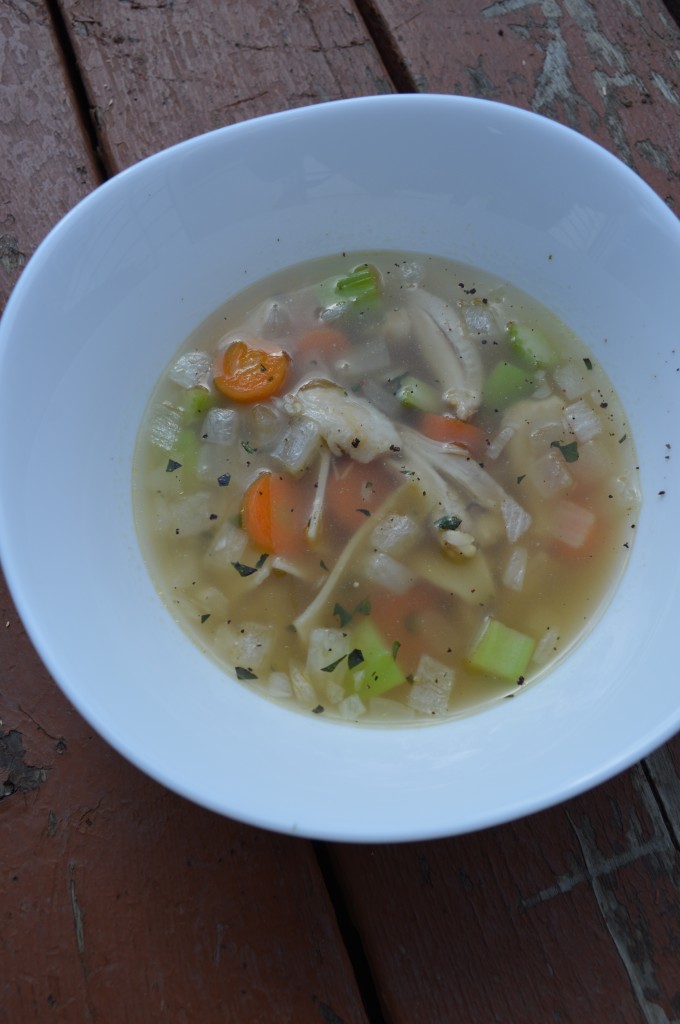As I mentioned in the Cutting Poultry post, one of the chief pleasures of buying whole birds from the market is that you get a bunch of bones with which to make stock.
You can make a small amount of light stock with one chicken carcass, or you can freeze the bones and collect a few carcasses so that you can make a whole pot. You can cut up your chicken, raw, into largely boneless pieces, and save the raw bones for stock. Or, if you roast the whole bird and pull the meat off at the table, you can save the cooked carcass for stock.
All the bones of the bird can go in the stock. The neck and back are particularly good. I like to set aside the wishbone. While this particular collarbone does not have the same Delphic power as that of a Thanksgiving turkey, it’s still fun to break.
If I have raw, uncooked chicken bones, I roast them very aggressively before making stock. Roasting produces richer flavours and colour, and makes a clearer stock. The slender bones of the chicken require very high heat, at least 450°F, to brown thoroughly. I deglaze the roasting pan with a small amount of cider, white wine, or even diluted vinegar if I’m hard-pressed. The fond that forms on the roasting pan is tasty, and the touch of acidity from the deglazing liquid will help dissolve collagen into gelatin and give the stock a richer mouthfeel.
As discussed in my post on making stock:
- start with cold bones, and very cold water
- bring to a simmer very slowly
- skim away foam and sludge
- simmer extremely gently, so it is steaming, and there are almost no bubbles
- simmer the bones overnight, then add the roasted vegetables for the last hour, and the fresh herbs for the last fifteen minutes.
Notes on Chicken Noodle Soup
Chicken noodle soup is perhaps the ultimate New World comfort food. (It’s main contenders would be macaroni and cheese, Thanksgiving stuffing, and pumpkin pie.) While a flavourful broth is the essential foundation of good chicken noodle soup, there are still many other factors to consider. First of all, it is important to leave a small amount of fat in the stock. Most cultures that make chicken broth recognize the importance of a few spots of gleaming fat floating on the surface. The most refined even have names for these spots. The French call them les yeux, “the eyes.”
The following are matters of personal taste.
A small amount of moist, tender chicken. When I was a kid I didn’t even like having chicken in my chicken noodle soup; I was perfectly content with broth and noodles. As a grown-up, I put a bit of meat into the soup, but not much; typically just some meat pulled from the carcass.
Lots of noodles. Obviously you can use whatever kind of noodle you want, but I prefer delicate noodles as opposed to chunkier, say, penne or bowtie. Sometimes stars align and I have made both chicken stock and fresh egg noodles. When you roll and cut fresh pasta into, say, tagliatelle, you always have a bit of misshapen pasta scraps left. They are occasionally sold to customers in fancy Italian restaurants as “rag pasta” or malfatti, which I think means “malformed,” roughly. Anyways, they’re great in soup. If you want a very clear broth, boil the pasta in a separate pot of water, or it will leach starch and cloud the soup.
Lots of herbs added shortly before serving. This is important. Herbs give up their strongest aromas and flavours after only a few minutes of simmering.
Lots of black pepper. Also important, especially if you have a runny nose.
Soda crackers soaked in broth cure most ailments, physical and spiritual.
